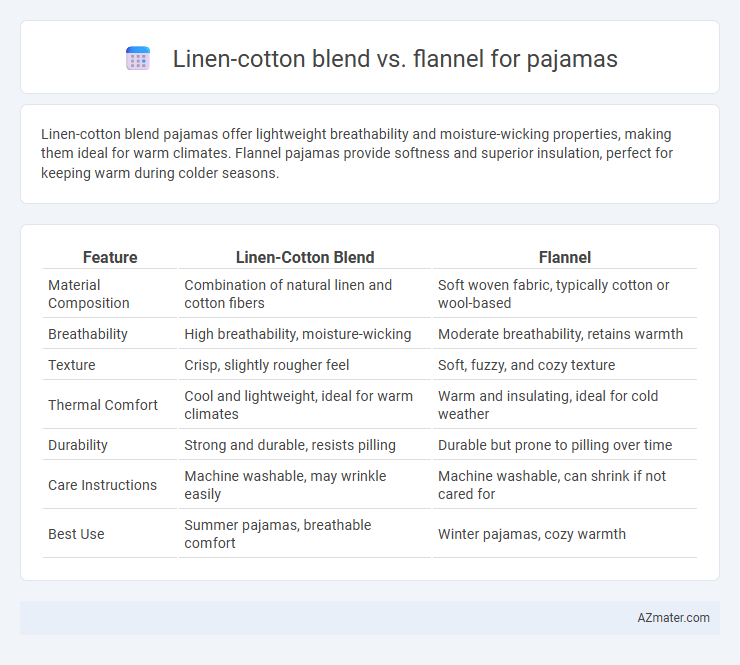Linen-cotton blend pajamas offer lightweight breathability and moisture-wicking properties, making them ideal for warm climates. Flannel pajamas provide softness and superior insulation, perfect for keeping warm during colder seasons.
Table of Comparison
| Feature | Linen-Cotton Blend | Flannel |
|---|---|---|
| Material Composition | Combination of natural linen and cotton fibers | Soft woven fabric, typically cotton or wool-based |
| Breathability | High breathability, moisture-wicking | Moderate breathability, retains warmth |
| Texture | Crisp, slightly rougher feel | Soft, fuzzy, and cozy texture |
| Thermal Comfort | Cool and lightweight, ideal for warm climates | Warm and insulating, ideal for cold weather |
| Durability | Strong and durable, resists pilling | Durable but prone to pilling over time |
| Care Instructions | Machine washable, may wrinkle easily | Machine washable, can shrink if not cared for |
| Best Use | Summer pajamas, breathable comfort | Winter pajamas, cozy warmth |
Introduction: Choosing the Right Pajama Material
Linen-cotton blend pajamas offer breathable comfort and natural moisture-wicking properties, making them ideal for warm climates or those seeking lightweight sleepwear. Flannel pajamas provide excellent insulation and softness, perfect for cooler nights and a cozy sleep environment. Selecting between these fabrics depends primarily on temperature preferences and desired texture for optimal nighttime comfort.
Overview of Linen-Cotton Blend Fabric
Linen-cotton blend fabric combines the breathability and moisture-wicking properties of linen with the softness and durability of cotton, making it an ideal choice for pajama material. This blend offers lightweight comfort with enhanced texture and reduced wrinkling compared to pure linen, promoting a cool and comfortable sleep environment. The fabric's natural fibers ensure good airflow and hypoallergenic benefits, suitable for sensitive skin and warmer climates.
What Is Flannel?
Flannel is a soft, woven fabric typically made from wool, cotton, or synthetic fibers, known for its warmth and cozy texture. It undergoes a brushing process that raises fine fibers, creating a plush surface ideal for cold-weather pajamas. Compared to linen-cotton blends, flannel provides superior insulation and comfort during colder seasons, whereas linen-cotton blends offer better breathability and moisture-wicking properties for warmer climates.
Breathability and Temperature Regulation
Linen-cotton blend pajamas excel in breathability due to linen's natural moisture-wicking properties combined with cotton's softness, making them ideal for warmer climates or those prone to overheating at night. Flannel pajamas, typically made from brushed cotton, provide superior warmth and insulation by trapping body heat, making them better suited for colder nights and cooler environments. Choosing between the two depends on the desired balance between temperature regulation and breathability, with linen-cotton offering a cooler sleep experience and flannel enhancing warmth.
Comfort and Softness Comparison
Linen-cotton blend pajamas offer superior breathability and moisture-wicking properties, making them exceptionally comfortable for warmer climates. Flannel pajamas, made from brushed cotton, provide a soft, cozy texture that excels in warmth and softness during cooler seasons. The choice between linen-cotton blend and flannel depends on desired comfort level and temperature regulation needs.
Durability and Longevity
Linen-cotton blend pajamas offer superior durability due to the combined strength and breathability of natural fibers, making them resistant to wear and tear over time. Flannel pajamas, while warm and soft, tend to show signs of pilling and fabric thinning after multiple washes, reducing their longevity. Choosing a linen-cotton blend ensures a longer-lasting pajama that maintains structural integrity and comfort through frequent use.
Maintenance and Care Instructions
Linen-cotton blend pajamas require gentle machine washing in cold water with mild detergent to maintain fabric softness and prevent shrinkage, and they benefit from air drying or low-heat tumble drying to avoid damage. Flannel pajamas, typically made of cotton or cotton blends, need washing in warm water to preserve the plush texture while using a gentle cycle and avoiding fabric softeners that can reduce softness; tumble drying on low heat or air drying helps maintain fluffiness. Regular maintenance for both fabrics includes avoiding bleach and ironing on low settings, with linen-cotton blends possibly benefiting more from light ironing to smooth wrinkles.
Style and Design Versatility
Linen-cotton blend pajamas offer a lightweight, breathable fabric with a natural texture that suits both casual and elegant styles, making them versatile for warm climates and relaxed designs. Flannel pajamas, characterized by their soft, brushed finish, provide a cozy, classic aesthetic ideal for colder weather and traditional or rustic patterns. The linen-cotton blend adapts seamlessly to minimalist and modern fashion, while flannel excels in layered looks and plaid or checkered motifs, reflecting distinctive style preferences.
Best Uses for Each Fabric in Different Seasons
Linen-cotton blends offer breathability and moisture-wicking properties, making them ideal for warm spring and summer nights when lightweight comfort is essential. Flannel fabric provides insulation and softness, perfect for keeping cozy during cold fall and winter months. Choosing between these fabrics depends on the desired temperature regulation and seasonal comfort for pajamas.
Conclusion: Which Material is Best for Your Pajamas?
Linen-cotton blend pajamas offer superior breathability and moisture-wicking properties, ideal for warmer climates and those seeking lightweight comfort. Flannel pajamas provide exceptional warmth and softness, making them perfect for cold weather and cozy indoor wear. Choosing between linen-cotton blend and flannel depends on your priority for temperature regulation and seasonal comfort during sleep.

Infographic: Linen-cotton blend vs Flannel for Pajama
 azmater.com
azmater.com